1994 CADILLAC ELDORADO reset
[x] Cancel search: resetPage 159 of 398

Downloaded from www.Manualslib.com manuals search engine TRANSFLUJJlRESET=48. .2. .. .. 1 ., . _,,. . :A -. v-. . .. .. , .- .
With the engine not running and the ignition ON, press and hold the
OFF and REAR DEFOG buttons until the TRANS FLUID'RESET
message appears in the Information Center (between 5 and 20 seconds).
TURN SIGNAL ON. - 20
This message is a reminder, after driving about a mile, that you have your
turn signal on.
TRUNK OPEN - 24
k
r
f
I
I
f L,
P
F
r
r
Speed Sensitive Steering (11 5s)
This system varies the amount of steering effort proportiabate to
your vehicle speed. Steering
is eesier at a lower speed for increased
maneuverability and parking ease.
As your vehicle speed increases, the'"-:
steering effort is also increased proportionately. At highway speeds the
amount
of steering effort is increased to provide a manual like steering
feel for maximum control and enhanced vehicle stability.
. ./ ; .
.. ..
Road Sensing Suspension
The Road Sensing Suspension automatically controls the ride of your
vehicle. The system controls damping
forces in the shock absorbers and
struts
in response to various road and driving conditions. The system is
capable
of making these changes within milli-seconds.
The Road Sensing Suspension controller is a computer used to control and
monitor the system. The computer receives inputs from vertical acceleration
sensors, wheel to body position sensors, vehicle speed sensor, lift and dive
signals,
and determines optimum strut valving or (suspension stiffness) for
your current operating conditions. The computer a1,so receives feedback
Page 161 of 398

Downloaded from www.Manualslib.com manuals search engine n n
r
I-- .,
I
r
r
r
The system probably will say. to change .& d between ,3000 miles
(5000 km) and ,7500 *miles. (125OO km), but it may even sary to change it
before
3000 under very severe conditions. It all depends on .your drivirrg
pattims.
If it’s been 7500 miles (12500 km) it,always says to’ change the oil.
There are two.thingslhe system doesn?t do:
0 It can’t sense. heavy dust in the.places where you- drive. If you -drive in
a dusty area, you should change your
oil -every 3000 miles (5000 km)
or 3 months (whichever comes first), unless the display says to chinge
it even sooner than that.
I
It doesn’t check how much oil you have, so you’ll still have to check
for that. To see how, see “Engine Oil.’’ in the Index.
men You’ve Changed the Oil
When new oi€ is,put in, you’ll need .to reset.your.system. To: do it, display
the “OIL LIFE
.INDEX’’ by pressing the INFORMATION button. Then
press -and;hold the RESET buttons until the display shows “POO-OIL
LIFE LEFT.”
Electronic Level .Control
This keeps your car level.
The ignition’has to be
“ON” for the level control to work. When,you turn
the ignition off, you may hear the level control exhausting. The,system
consists
of an electronic rear position sensor, a smalldectric air
compressor, and air adjustable
SI kabsorbers mounted on the rear of
the vehicle.
If the system has .a slight leak, the air compressor will run frequently for a
few seconds each time.
i For a massive air leak, the air ‘compressor will stay on for. approximately
7 minutes. You should see your.deal.er for service, but.you can keep
driving ,your Cadillac.
149
Page 232 of 398
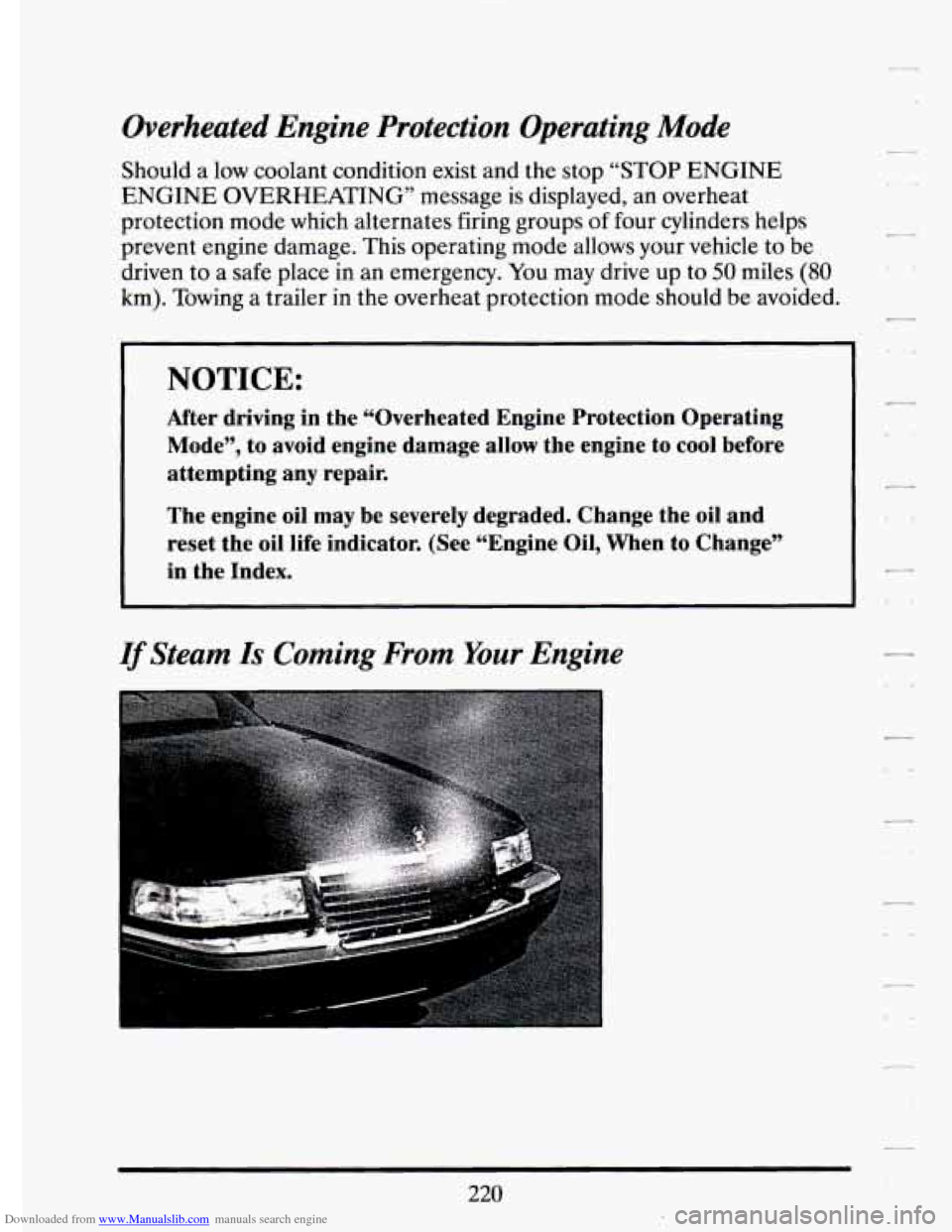
Downloaded from www.Manualslib.com manuals search engine Overheated Engine Protection Operating Mode
Should a low coolant condition exist and the stop “STOP ENGINE
ENGINE OVERHEATING” message is displayed, an overheat
protection mode which alternates firing groups
of four cylinders helps
prevent engine damage. This operating mode allows your vehicle
to be
driven to a safe place in an emergency. You may drive up to 50 miles (80
km). Towing a trailer in the overheat protection mode should be avoided.
NOTICE:
After driving in the “Overheated Engine Protection Operating
Mode”, to avoid engine damage allow the engine to cool befo\
re
attempting any repair.
The engine oil may be severely degraded. Change the oil and
reset the oil life indicator. (See “Engine Oil, When to Change”
in the Index.
If Steam Is Coming From Your Engine
220
Page 269 of 398
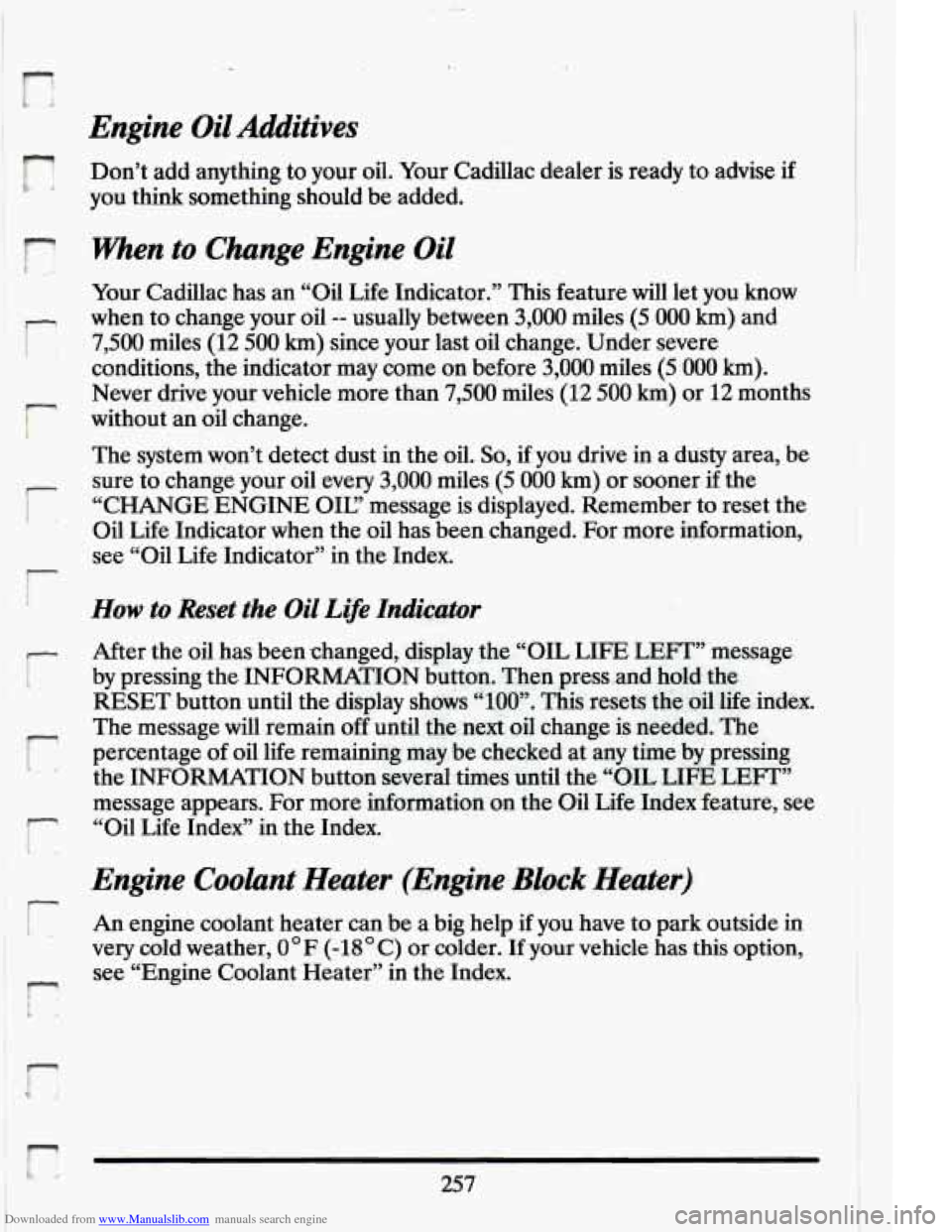
Downloaded from www.Manualslib.com manuals search engine Engine Oil Additives
k Don’t add anything to your oil. Your Cadillac dealer is ready to advise if
you think something should be added.
‘C When to Change Engine Oil
r
r
3 r
r
r
r
Your Cadillac has an “Oil Life Indicator.” This feature will let you know
when to change your oil
-- usually between 3,000 miles (5 000 km) and
7,500 miles (12 500
km) since your last oil change. Under severe
conditions, the indicator may come on before
3,000 miles (5 000 km).
Never drive your vehicle more than 7,500 miles (12 500 km) or 12 months
without an oil change.
The system won’t detect dust in the oil.
So, if you drive in a dusty area, be
sure to change your oil every 3,000 miles (5 000 km) or sooner if the
“CHANGE ENGINE OK’ message is displayed. Remember to reset the
Oil Life Indicator when the oil has been changed. For more information,
see “Oil Life Indicator” in the Index.
How to Reset the Oil Life Indicator
r
After the oil has been changed, display the “OIL LIFE LEFT” message
by pressing the INFORMATION button. Then press and hold the
RESET button until the display shows
“loo”.. This resets thle.,oil life index.
The message will remain
off until the next oil change is needed. The
percentage of oil life remaining may be checked at any time by pressing
the INFORMATION button several times until the
“OIL LE% LEFT”
message appears. For more information on the Oil Life Index feature, see
“Oil Life Index” in the Index.
Engine Coolant Heater (Engine Block Heater)
An engine coolant heater can be a big help if you have to park outside in
very cold weather, O°F (-18O C) or colder. If your vehicle has this option,
see “Engine Coolant Heater” in the Index.
257
Page 274 of 398
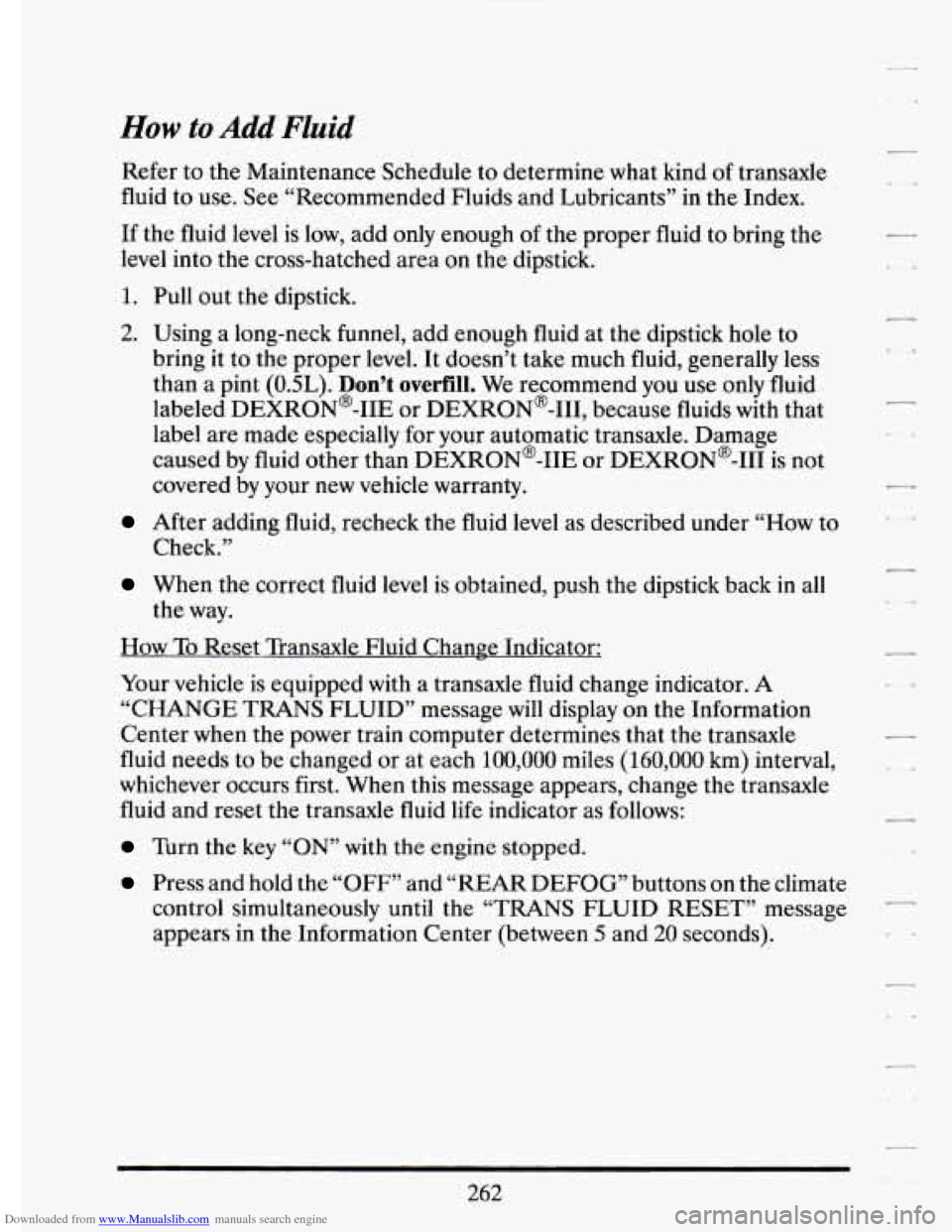
Downloaded from www.Manualslib.com manuals search engine How to Add Fluid
Refer to the Maintenance Schedule to determine what kind of transaxle
fluid
to use. See “Recommended Fluids and Lubricants” in the Index.
If
the fluid level is low, add only enough of the proper fluid to bring the
level into the cross-hatched area on the dipstick.
1. Pull out the dipstick.
2. Using a long-neck funnel, add enough fluid at the dipstick hole to
bring it to
the proper level. It doesn’t take much fluid, generally less
than
a pint (OSL). Don’t overfill. We recommend you use only fluid
labeled DEXRON@-IIE or DEXRON@-111, because fluids with that
label are made especially for your automatic transaxle. Damage
caused by fluid other than DEXRON@-IIE or DEXRON@-I11 is not
covered by your
new vehicle warranty.
After adding fluid, recheck the fluid level as described under “How to
When the correct fluid level is obtained, push the dipstick back in all
Check.”
the way.
How To Reset Transaxle Fluid Change Indicator:
Your vehicle is equipped
with a transaxle fluid change indicator. A
“CHANGE TRANS FLUID” message will display on the Information
Center when the power train computer determines that the transaxle
fluid needs to be changed or at each
100,000 miles (160,000 km) interval,
whichever occurs first. When this message appears, change the transaxle
fluid and reset the transaxle fluid life indicator as follows:
Turn the key “ON” with the engine stopped.
Press and hold the “OFF” and “REAR DEFOG” buttons on the climate
control simultaneously until the “TRANS FLUID RESET” message
appears in the Information Center (between
5 and 20 seconds).
262
Page 278 of 398
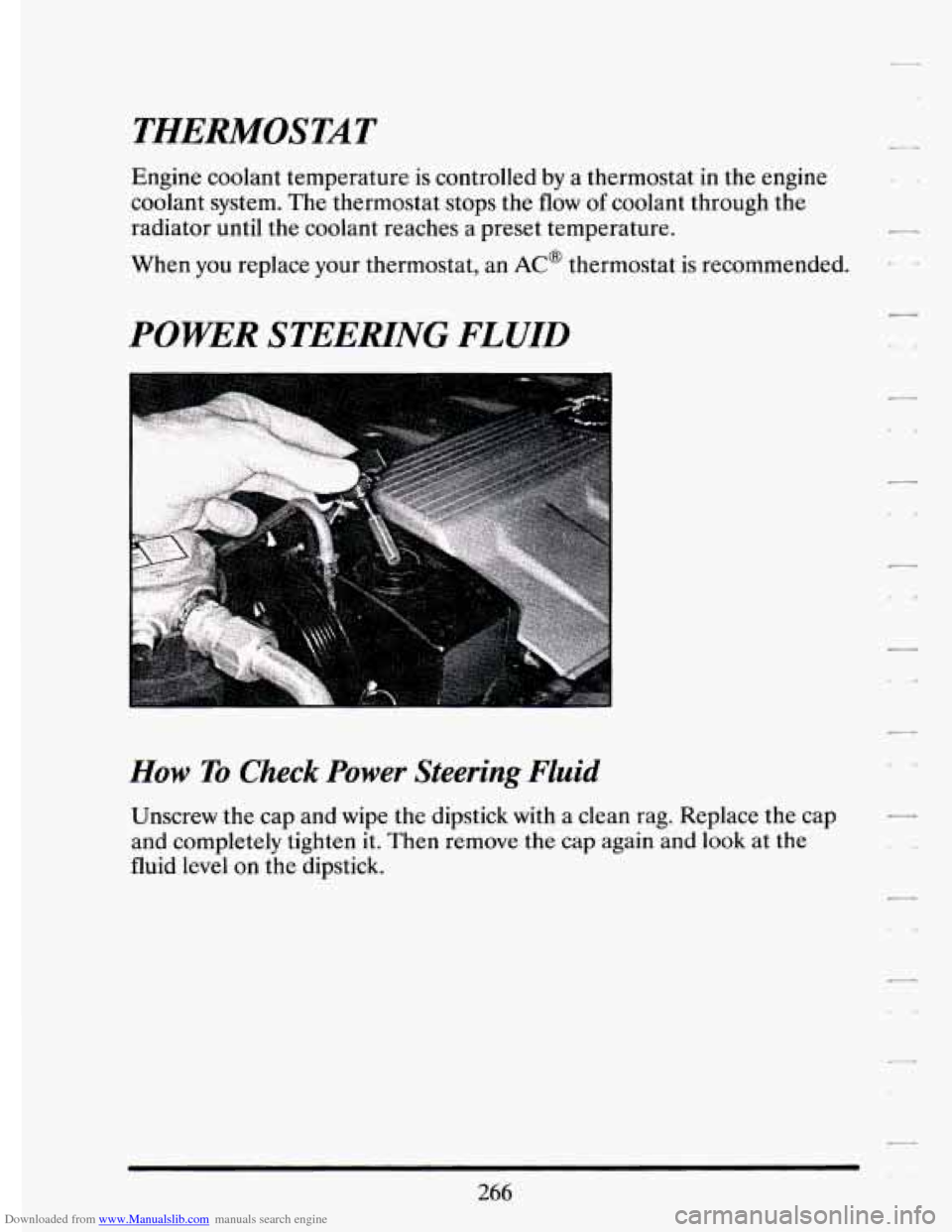
Downloaded from www.Manualslib.com manuals search engine THERMOSTAT
Engine coolant temperature is controlled by a thermostat in the engine
coolant system. The thermostat stops the flow
of coolant through the
radiator until the coolant reaches
a preset temperature.
When
you replace your thermostat, an AC@ thermostat is recommended.
POWER STEERING FLUID
How To Check Power Steering Fluid
Unscrew the cap and wipe the dipstick with a clean rag. Replace the cap
and completely tighten
it. Then remove the cap again and look at the
fluid level
on the dipstick.
266
Page 308 of 398
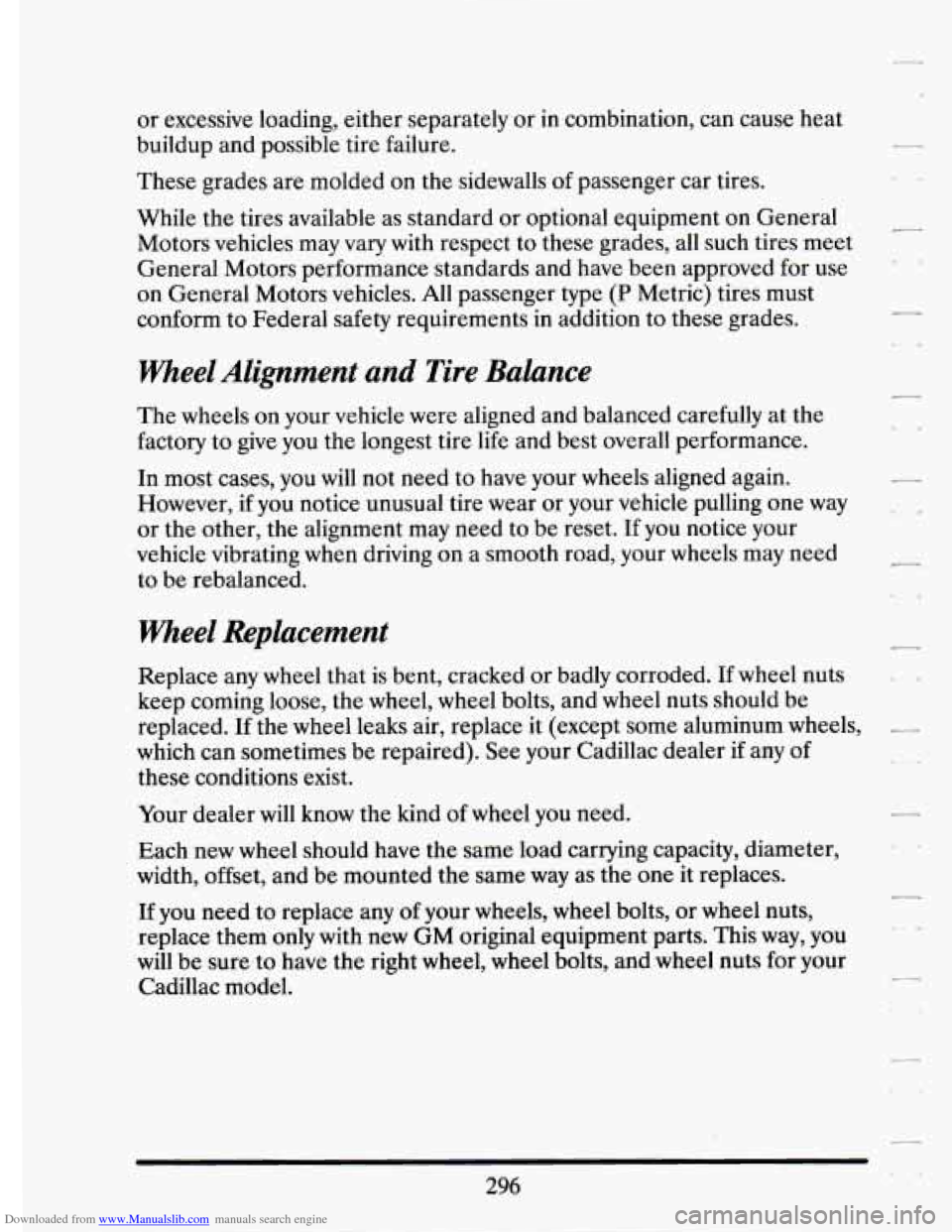
Downloaded from www.Manualslib.com manuals search engine or excessive loading, either separately or in combination, can cause heat
buildup and possible tire failure.
These grades are molded on
the sidewalls of passenger car tires.
While the tires available as standard or optional equipment on General
Motors vehicles may vary with respect to these grades, all such tires meet
General Motors performance standards and have been approved for use
on General Motors vehicles. All passenger type
(P Metric) tires must
conform to Federal safety requirements
in addition to these grades.
Wheel Alignment and Tire Balance
The wheels on your vehicle were aligned and balanced carefully at the
factory to give you the longest tire life and best overall performance.
In most cases, you
will not need to have your wheels aligned again.
However,
if you notice unusual tire wear or your vehicle pulling one way
or the other, the alignment may need to be reset. If you notice your
vehicle vibrating when driving
on a smooth road, your wheels may need
to be rebalanced.
Wheel Replacement
Replace any wheel that is bent, cracked or badly corroded. If wheel nuts
keep coming loose, the wheel, wheel bolts, and wheel nuts should be
replaced. If the wheel leaks air, replace it (except some aluminum wheels,
__
which can sometimes be repaired). See your Cadillac dealer if any of
these conditions exist.
Your dealer will know the kind
of wheel you need.
Each new wheel should have the same load carrying capacity, diameter,
width, offset, and be mounted the same way as the one it replaces.
If you need to replace any of your wheels, wheel bolts, or wheel nuts,
replace them
only with new GM original equipment parts. This way, you
will be sure to have the right wheel, wheel bolts, and
wheel nuts for your
Cadillac model.
296